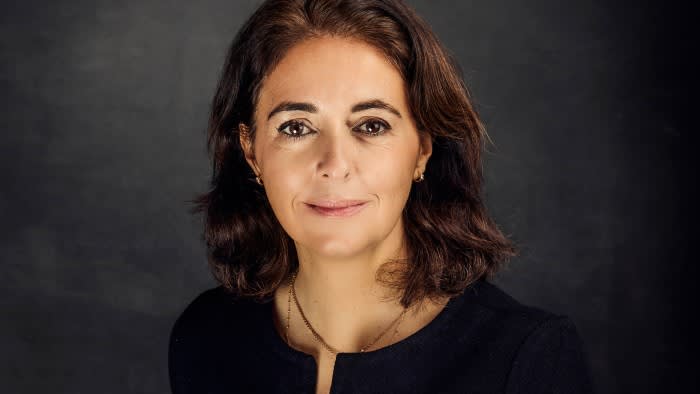The top floor of the Centre Pompidou is one of Paris’s most popular viewing spots. And, this summer, the contemporary art museum played host to the launch of Repossi’s latest high jewellery collection — perhaps a metaphor for its ambitions to project an outsized image of its brand.
Repossi also sponsored an exhibition dedicated to the French-Romanian artist Constantin Brâncuși, held at the Centre Pompidou over the summer, to which its clients were granted privileged access. “It is a challenge to compete with much bigger brands with bigger budgets, but even a small brand can come up with a project that is impactful,” argues Repossi chief executive Anne de Vergeron. She says she was pleased with the success of the collaboration with the museum.
A former investment banker at UBS, de Vergeron joined LVMH as group director of business development in 2015. One of her first deals on behalf of the luxury conglomerate was to buy into Repossi the same year, initially taking a minority stake. LVMH then became the majority shareholder in April 2018, when it increased its stake to 68 per cent.
Back in 2015, Luca Solca — a luxury sector analyst then at Exane BNP Paribas and now with Bernstein — had valued Repossi’s annual revenue at €50mn. He now believes that figure could have doubled under LVMH’s leadership.
Even so, when comparing Repossi’s estimated revenue with estimates for other jewellery brands’ revenues, made by Morgan Stanley, it is clear that Repossi remains the smallest in the LVMH stable — behind Tiffany & Co (€5.3bn), Bulgari (€3.5bn), Chaumet (€464mn), and Fred (€152mn).
De Vergeron says that LVMH has traditionally looked to take over brands with “a strong DNA and a deep history”, as well as creativity and superior-know-how. “But we also need to sense that the brands have the potential to grow and that we can help them in their development,” she explains.
Founded in 1957 in Turin, by Costantino Repossi, the brand became known for its opulent, diamond-studded, Renaissance-inspired pieces laden with gobstopper-sized coloured gemstones. One such piece was the Dis-Moi Oui cocktail ring, which featured in the last season of The Crown when Dodi Al Fayed gave it to Diana, Princess of Wales as a gift.
Since 2007, Repossi has been under the guidance of Gaia Repossi as creative director. She is the third generation of the family to enter the business, and has forged a sleek, sculptural visual identity influenced by her studies in painting and social anthropology. It is a different direction that draws a contrast with Repossi’s past — and also with its traditional Parisian neighbours on Place Vendôme. The trusted workshops in Italy, loyal to the brand since its inception, embraced the new design challenges and are still serving it today.
The brand’s collections include the architectural Berbère, Blast, Serti Inversé, Serti sur Vide and Antifer. The latter is celebrating its 10th anniversary with a series of commissioned artworks from artists such as Victoire d’Harcourt and Martha Freud.


But, while a strong aesthetic defines a brand, it does not build a company. “When I entered the business, we had a lot of entry-price pieces and a lot of higher-priced items, between €500,000 and €1mn, but not much in the middle range,” de Vergeron recalls. “The challenge was to build bridges across the different price points to allow customers to move across the different assortments and prices. Reaching this balance has taken about two years.”
De Vergeron focused on pieces for €20,000-€150,000 and extending the range. “When I took over, 80 per cent of Repossi’s offer consisted of rings — and rings are not for everyone. Now, we have about 40 per cent rings, 25-30 per cent earrings, and the rest a mix of bracelets and necklaces. However, rings are still very representative of the brand,” she adds.
The Serti sur Vide collection, for which the latest creations were presented in late June in Paris, is the first complete product range, taking in more accessible fine jewellery as well as high jewellery.

Repossi already has a presence in the US and Japan, and de Vergeron is keen to focus on international expansion in places such as South Korea and the Middle East.
“Branded jewellery is a fast-growing sector, with very few luxury heritage maisons,” says Mario Ortelli, managing director at luxury goods consultancy Ortelli & Co. He believes that LVMH is currently accelerating the development of its small maisons, such as Chaumet and Fred. “Being part of LVMH is an advantage in accessing financial resources to make investments and secure locations in malls and department stores,” he says.
Milton Pedraza, chief executive of the Luxury Institute in New York, suggests Gaia’s social presence is another advantage for Repossi, “because clients can relate to an individual who is a family member, and trusted personal client relationships can be built”. However, he warns that, “longer term, the brand must create continuity beyond an individual to survive and thrive”.
Repossi has so far made a substantial impact with limited resources and inventiveness, particularly in the US. As de Vergeron points out: “Repossi was the main sponsor of the [US postwar artist] Donald Judd show at MoMA in New York three years ago, and his son Flavin redesigned our historical store in Monaco in 2021.”
“Donald Judd is an important reference in our brand’s creative expression,” she says, underlining the link with contemporary art that is part of the brand’s identity.
Although the luxury market is experiencing slow growth currently, de Vergeron is confident in Repossi’s strength — and clients’ appetite to discover niche brands. “We are one of the smallest houses on the Place Vendôme, and we operate as a start-up, but we still have over 60 years of history,” she says, “We are a 60-year-old start-up.”


